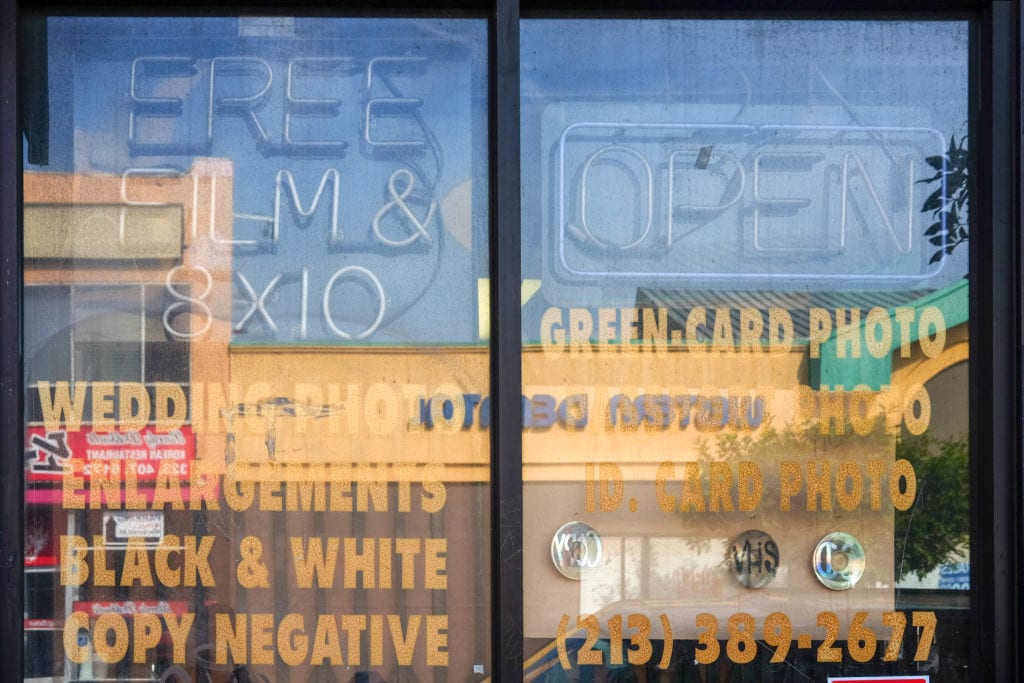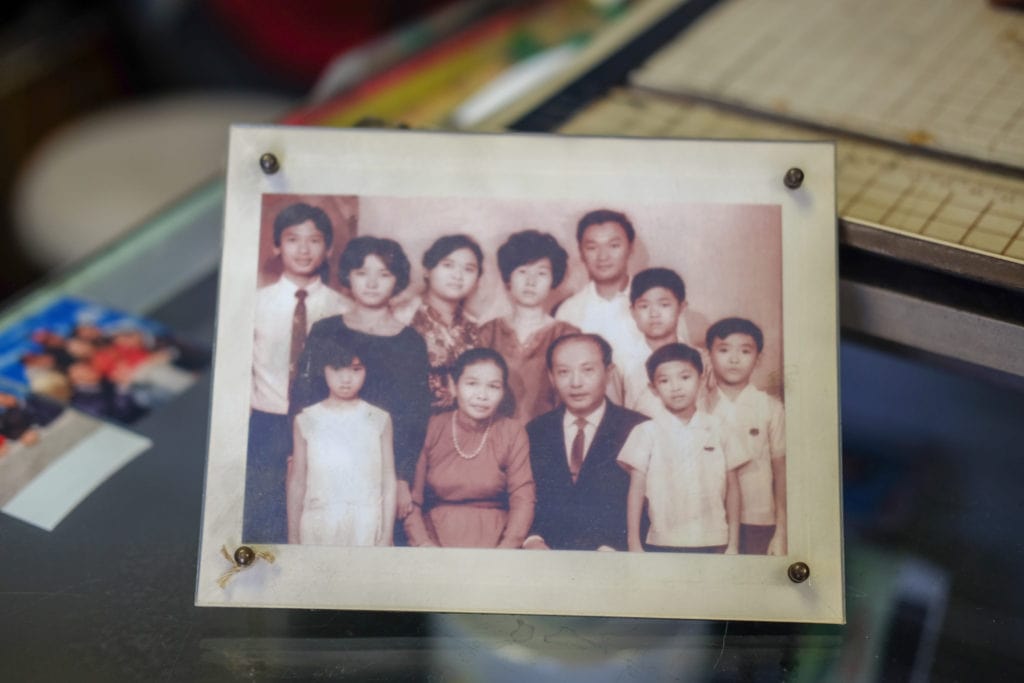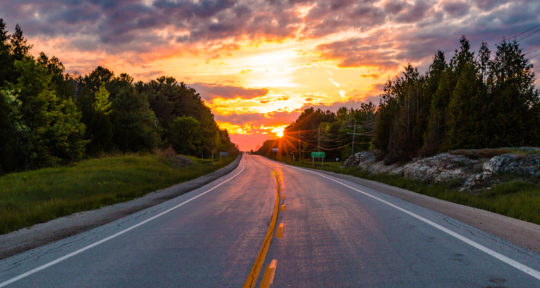On a recent weekday afternoon, the small storefront of Tom’s One Hour Photo Studio, located in a working-class neighborhood of Los Angeles, looks practically ordinary. The studio is cluttered with bric-a-brac amassed over several decades: assorted camera cords, packages of batteries, hand-painted backdrops, drawings and sketches, and a small mountain of photo props. On this particular day, Tom, the studio’s owner and sole photographer, only has one customer.
After the customer finishes up her photo session and leaves, the shop is quiet again. There are no reporters or camera crews from local TV stations. This sense of normalcy belies the fact that, two months ago, customers lined up outside to get their photos taken by Tom. The shop’s phone rang off the hook for weeks as Tom and his wife worked overtime to keep up with the demand.
At first, they didn’t know what sparked the sudden boom in business. But Tom quickly learned that singer-songwriter Kacey Musgraves had visited his store in August—and she had tweeted about him.
A weathered sign outside the shop. | Photo: Amanda Ulrich The street entrance to Tom’s studio. | Photo: Amanda Ulrich One of Tom’s workspaces. | Photo: Amanda Ulrich A pile of photo props, some of which Tom has made by hand. | Photo: Amanda Ulrich Old signage promises everything from wedding to green card photos. | Photo: Amanda Ulrich Rolled-up photo backdrops line the back studio wall. | Photo: Amanda Ulrich
Musgraves wrote that she and her sister had found the studio last minute and stopped in for a few photos. They ended up hearing Tom’s story—about how the digital age had stunted revenue for a business that once relied solely on film photography—and decided to make him a fan Instagram account.
For Tom, the chaos that ensued was like a “24-hour movie,” he says. Musgraves-fans-turned-customers showed up by the hundreds. Tom’s story appeared in Rolling Stone, The New York Times, and The LA Times—over eight pages of Google search results in total.
Turning a dream into a business
The newfound business was very much appreciated, Tom says, but still overwhelming. His wife quit her job at a nail salon to help work the front desk, and Tom considered hiring another photographer. “Sometimes I talk to my wife and say, ‘I’m not a machine,’” he says. “I [would] hold a camera and work a whole day like this, no eating, no nothing. But I don’t want to keep the customer waiting.”
Musgraves’ influence on the studio is now writ large. But the store, and Tom himself, has weathered other major highs and lows over the last 40 years. Tom first came to the United States from Vietnam as a teenager in 1979. He was alone, couldn’t speak English, and had no money. At the time, he was still going by his full Vietnamese name, Tuong Tai Hiep.
Tom stands by a backdrop he designed and painted himself. | Photo: Amanda Ulrich Tom writes his full Vietnamese name: Tuong Tai Hiep. | Photo: Amanda Ulrich A family portrait from Tom’s childhood. | Photo: Amanda Ulrich Tom poses in front of one of his own backdrops. | Photo: Amanda Ulrich
“First year—no English, no nothing. No car, no nothing. You don’t know where to go,” Tom says. “I knew some friends who came here in 1975, they came here first. They’d say, ‘You want a coffee? You go here. You want to go eat? Okay, you go here. You want to go to an American market or Vietnamese market? You have to go there.’”
In those first few years, Tom picked up a slew of different jobs, most of which only paid about $2 an hour. For a while, he worked a night shift delivering newspapers. Gradually, Tom learned English by striking up conversations and watching American TV shows. He bought a car, got married, and helped bring the rest of his family to the U.S.
Before he had his own photography business, Tom was always holding a camera, taking photos at parties, weddings, and other special events. When he first opened his studio in the late 1980s, it was a lifelong passion finally come to fruition.
“I thought, ‘Photo for my whole life,’” Tom says. “Everybody needs a photo: family or friend or baby or whatever. Everybody needs a photo.”
For a time, Tom found that to be true. The shop was busy and business was going well. Then, about two decades ago, things started to shift. Digital cameras made film increasingly obsolete, and trained photographers became less of a necessity. The first cell phones with built-in cameras came out in 2002, paving the way for instant photo-sharing. After the digital wave, sales went “all the way” down, Tom says. Other photographers in traditional studios saw the writing on the wall and went to find different work.

“They were quick and they went to work another job. Normally I would have had to quit too,” Tom says. “Because I stayed here I didn’t make money. But my wife said, ‘Just keep [the store]. So I still sat here waiting and waiting, and I was lucky that Kacey came. And they helped me get back again.”
Family photos
Today, Tom’s studio is, of course, covered with photos. Tacked on the walls are ‘80s-inspired headshots, baby photos, brides in wedding dresses, and framed photos of siblings wearing color-coordinated outfits. But Tom only has one family portrait from his own childhood. The rest were lost—along with almost all of his possessions—during his hazardous journey to the U.S.
Tom brings out the picture from behind his workspace and points out who’s who. His parents sit stoically in the front, a 10-year-old Tom sits behind them. The composition isn’t unlike photos Tom himself has taken since: a group positioned perfectly for the camera, limbs arranged demurely.
Tom says when he first came to the U.S., about nine years after that photo was taken, success was never a guarantee. When it comes to what happened with Kacey Musgraves, he talks a lot about the randomness of luck.
Tom looks over photos with a customer. | Photo: Amanda Ulrich Tom’s One Hour Photo is filled with framed shots from past photo sessions. | Photo: Amanda Ulrich The studio is wedged between other mom-and-pop stores, including a pet supply business. | Photo: Amanda Ulrich Examples of different photo sizes and styles offered at the shop. | Photo: Amanda Ulrich
It’s hard not to notice the other mom-and-pop stores on the same street that haven’t experienced the same elusive success story that Tom has—one where an internationally-acclaimed artist helps put your business on the map. Near Tom’s place is a small pet supply store, a cell phone accessory shop, a 99 cent “depot,” and dozens of other businesses.
“With the American dream, sometimes you don’t know,” Tom says. “Sometimes you live your whole life [wondering] how you can get the news to come here, talk with you. I never got it. Your dream, but you don’t have it. Now I say I’m lucky.”
If you go
Tom’s One Hour Photo is open from 10:30 a.m. to 7 p.m. Monday through Saturday and until 6 p.m. on Sundays.




















